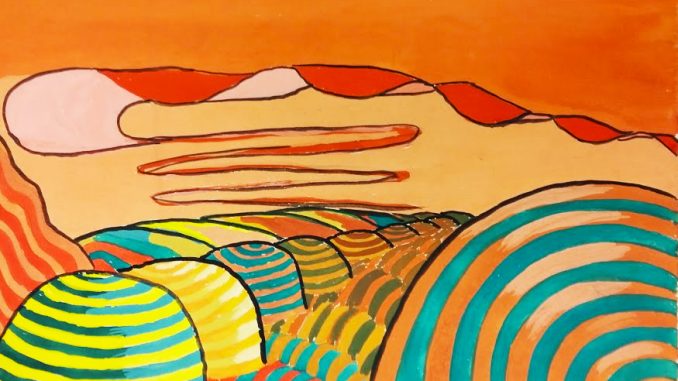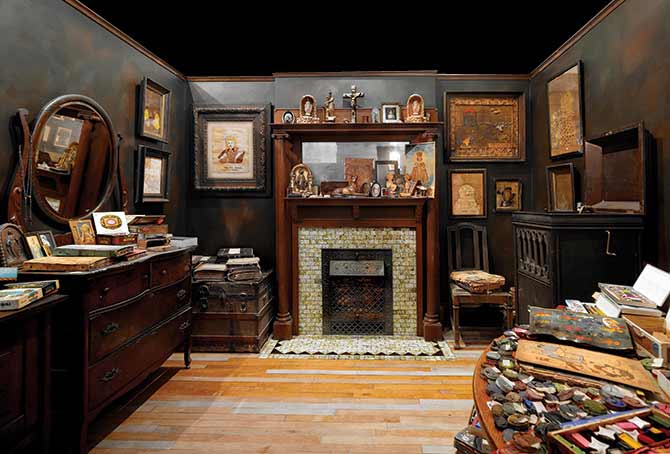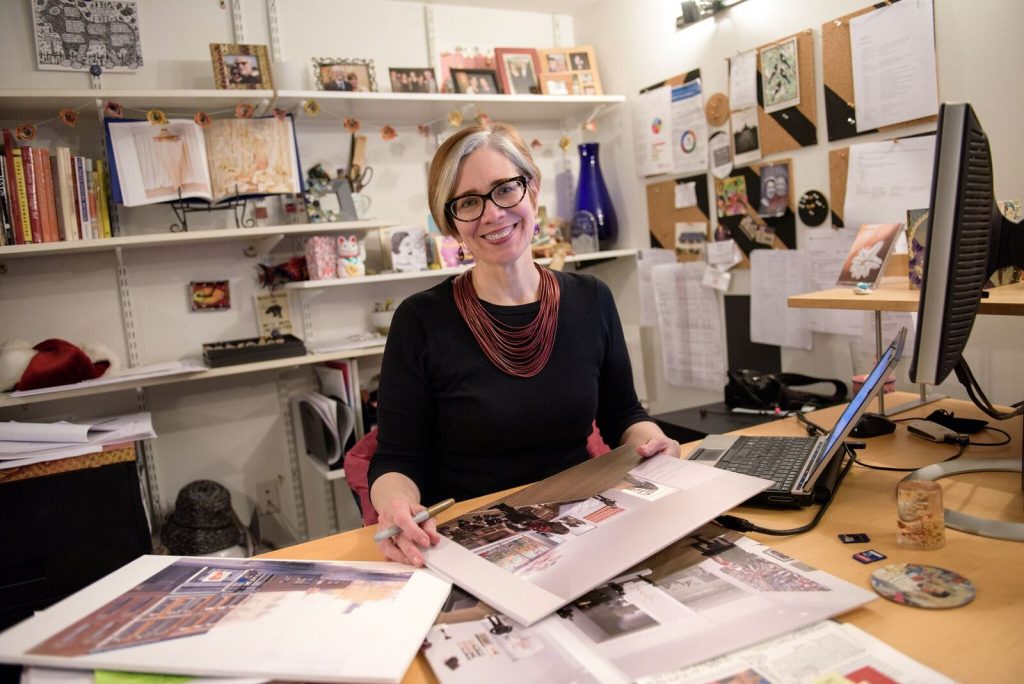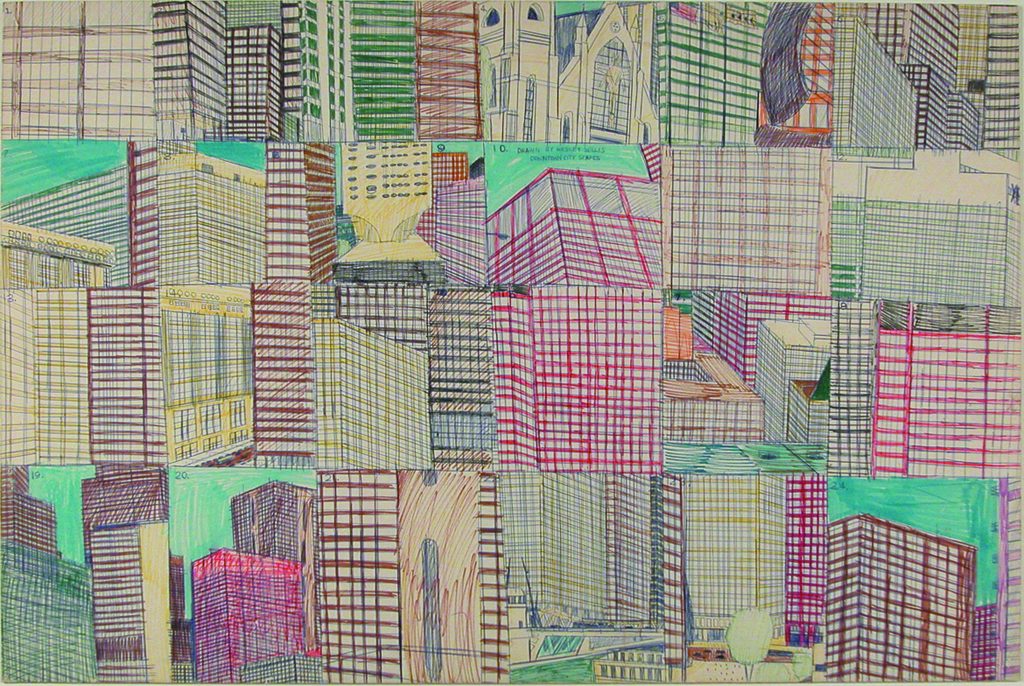
On a bitterly cold winter day, I entered the big red brick building at 756 N. Milwaukee Ave., Chicago housing Intuit: The Center for Intuitive and Outsider Art. There I met and was instantly engaged by knowledgeable enthusiastic museum personnel, visited a re-creation of an artists’ aerie, and was swept into an engrossing world of ingenious artworks, much of it heavily flavored with the fantastic.
Established in 1991, Intuit is one of the premier museums of outsider and self-taught art in the world. The museum provides resources for scholars and students, hosts educational programming on all levels for people of all backgrounds, presents exhibitions, and contains a permanent collection of more than 1200 works. The museum is home to the Henry Darger Room Collection, a fascinating glimpse into the reclusive yet abundantly prolific artistic life of a native Chicago artist. I was touched and transported by my experience in this realm, and also astonished at the mass of objects it contained.
Henry Darger, born in Chicago in 1892, lost his mother to “childbed fever” when he was 4; he never knew his sister. When he was 8, his poverty-stricken and crippled father was “taken” to a Catholic Mission home and the child himself was placed in a Catholic Boys’ home. After escaping from an asylum for “the feeble-minded”, at 16 he began a series of lifelong janitorial jobs in Chicago area Catholic Hospitals. In 1930, he settled into the room at 851 W. Webster that would be his home for 43 years.

In the spring of 2000, Intuit took possession of the contents of his living/working space, a seemingly bewildering array of tracings, newspaper and magazine clippings, documents of all kinds, collected architectural parts, etc. In 2008, the museum opened the permanent exhibit that invites museumgoers into the space where the artist lived and created enormous illustrated stories, paintings and collages. His work runs the gamut from idyllic fantasy creatures and landscapes to representations of horror and the murder of children; Darger was consumed with the goal of protecting abused and neglected kids.
The installation at Intuit brings into stark relief the compartmentalization and marginalization of this complicated human being while demonstrating graphically how his art flourished despite- or because of- the confines of his life, hidden away in a corner in the midst of a metropolis.
In fact, it is no coincidence that this museum is located in Chicago, a city that was among the earliest to catch on to the aesthetic value of Outsider- sometimes called “naïve”- art. Collectors Marjorie and Harvey Freed, for example, 2 of the founders of Intuit, were early aficionados whose collection spotlights the pioneering role Chicago had in recognizing this type of art. They collected works by “Lee Godie, the mainstay of Michigan Avenue; Wesley Willis, revered on Chicago’s indie rock scene; Tony Fitzpatrick, a modern-day Chicago artist working in the naive vernacular”. Intuit has numerous significant pieces by Chicago-based artists and of course, by many others.
The first question I asked of the intense, passionate and extremely witty Intuit Executive Director Debra Kerr was “What is intuitive/outsider art?” Kerr is a professional with an encyclopedic mastery of her field. I quickly discerned that this was like asking a lawyer how she can defend someone who is innocent. To the uninitiated, the question seems important; to those in the know, it is not just sophomoric, but opens up a vast area of discourse. Kerr and her colleagues sent me home with volumes of their magazine “The Outsider”, and a strong desire to research further information.

“Art brut” is a French term that translates as ‘raw art’, first used by the French artist Jean Dubuffet to describe art such as graffiti, the work of the insane, prisoners, children, and primitive artists that is made outside the academic tradition of fine art. He saw this type of art as “the raw expression of a vision or emotions, untrammeled by convention”.
Roger Cardinal, Professor Emeritus at the University of Kent, published the first book in English, Outsider Art, 1972, on the subject of Art Brut; he is credited with coining the phrase “outsider art”. Cardinal co-curated a hallmark show called “Outsiders” in 1979 at the Hayward Gallery, London, and has published extensively about particular Outsider artists as well as on prison art and autistic art/memory. “I believe that a paramount factor in the critical definition of the creative Outsider is that he or she should be possessed of an expressive impulse and should then externalize that impulse in an unmonitored way which defies conventional art-historical contextualization.” Roger Cardinal, Outsider Art, 1972.
Generally speaking, Outsider Art refers to work created by artists who are self-taught, (not made by students of the Art Institute of Chicago, for example). What is more, these artists have had little or no contact with art institutions or the “mainstream” art world; you will most likely not see their work prominently exhibited at EXPOChicago, although Outsider Art has indeed emerged as a successful art marketing category. Debra Kerr advised that a key aspect of the artists whose work is curated at Intuit is their compulsion and drive to create; they MUST make art!
Dubuffet and Cardinal were writing primarily about extremely marginalized European artists: psychotics, mediums, and eccentrics. This has caused the common misconception that Outsider Art is essentially pathological, when in fact the central characteristic shared by Outsiders is simply their lack of conditioning by art history or art world trends.
However, one of the most fascinating segments of the inquiry about such artistic “outsiders” is the impact of/juxtaposition with mental illness and creativity. To quote Cathy Malchiodi, PHD, “Emotional disorders are not afflictions that sometimes come with a built-in creativity boost”, she notes in Psychology Today, 1/5/2009. Malchiodi goes on to discuss the work of outsider artist Martin Ramirez, an artist diagnosed with schizophrenia who spent much of his adult life in an institution, as well as the work of artist Stephen Wiltshire, who “happens to be a person with autism”. She suggests that “human creativity is complex and ultimately, it is appreciated for its merit, innovation and imagination”.

In the interests of bringing a humanistic approach to and shedding light on the relationship between mental illness and creativity, Intuit will screen the film Between Madness and Art: The Prinzhorn Collection on Thursday, March 1, 2018 at 7 P.M. at the museum, 756 N. Milwaukee Ave. The movie addresses the issue, “What is the link between psychological states and the creative process?” and tries to answer the question, “Is there a relationship between psychosis and the artistic impulse?” Intuit is hosting this screening in conjunction with Rare Nest Gallery’s exhibition Otto Neumann: Modern Degenerate.
It wasn’t possible to take in all the permanent collection in one visit, but I did get an information-packed personal tour hosted by Alison Amick, Senior Manager of Exhibitions and Development, Chief Curator and Annaleigh Wetzel, Marketing Coordinator of In the Land of Pasaquan: The Story of Eddie Owens Martin. Curated by folklorist Fred C. Fussell, and originating from the La Grange Art Museum, this dramatic and brilliantly colored exhibition features a large selection of never-before-seen original drawings, sculptures, paintings, regalia, adornments and other examples of art by St. EOM, the name by which the artist referred to himself in his later years.
St. EOM was a visionary artist whose artistic visions were utopian in nature, although informed by various traditions. Asian and African influences are abundant in the sketches, paintings, textiles, sculptures, and items of adornment. Pasaquan is a 7 acre compound including 6 major structures- one “a kaleidoscopic cathedral”- with 4 acres of painted concrete walls. Martin, who told fortunes to earn a living, inherited the land from his mother, and transformed it into a “psychedelic wonderland”, since 2008 listed on the National Register.
The exhibition at Intuit uses original artwork, panels containing informational text, and a myriad of contemporary/vintage photographs which incorporate the mystical/religious/deeply playful ambience of Martin’s universe of Pasaquan. In an interview with journalist Tom Patterson, St. EOM said of the inspiration for his dreamscape, “I never had any overall plan…I just knew that I could see these designs in my mind, and these beautiful symbols- very weird. And I knew they represented the universe and its forces and the great powers that hold all of this planet here together.”

Winter Scenes from the Intuit Collection
Stephen Warde Anderson: Attention to Detail
In the Land of Pasaquan: Eddie Owens Martin; photo by Cheri Eisenberg
CURRENT EXHIBITIONS INCLUDE:
– Black Voices from the Collection, February 9-March 18, 2018
–Stephen Warde Anderson: Attention to Detail, January 26-May 13, 2018
– In the Land of Pasaquan: The Story of Eddie Owens Martin, December 22, 2017–March 11, 2018
– Highlights from the Intuit Collection, Ongoing
Intuit is open to the public Tuesday-Saturday, 11 a.m.-6 p.m.; Thursday, 11 a.m.-7 p.m.; Sunday, noon-5 p.m.; and Monday school holidays. More information at www.art.org.

Be the first to comment